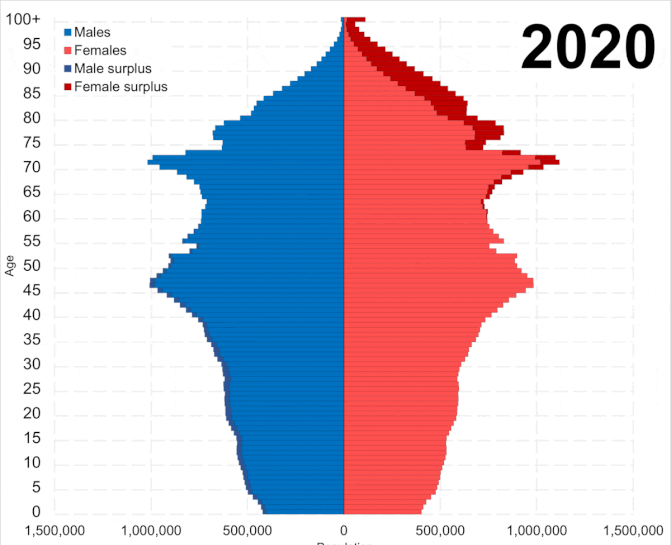26.06.2024
The Economic and Social Effects of Japan's Aging Population: Lessons for Germany and Europe
Japan's aging population presents a compelling case study for nations worldwide grappling with similar demographic trends. As the proportion of elderly citizens increases, profound economic and social implications emerge. For Germany and Europe, understanding these effects is crucial for crafting effective policies to address their own aging populations.
Japan's Demographic Landscape
Japan is home to one of the world's most rapidly aging populations. As of 2023, approximately 28% of Japan's population is over 65, a significant increase from 12% in 1990. This demographic shift results from both high life expectancy, currently around 84 years, and low fertility rates, which have remained below the replacement level of 2.1 children per woman since the 1970s. Consequently, Japan's population is shrinking, dropping from a peak of 128 million in 2010 to an estimated 124 million in 2023, with projections indicating a further decline to 88 million by 2065.
Economic Impact
The economic ramifications of an aging population are multifaceted. One of the most significant impacts is on the labor market. With a shrinking working-age population, Japan faces a labor shortage, which hampers economic growth. In 2022, Japan's labor force participation rate for those aged 15-64 was 77%, up from 74% in 2000, indicating efforts to mitigate the workforce decline. However, this increase has not fully compensated for the declining number of workers.
The labor shortage has also led to higher wages, particularly in sectors with severe shortages like healthcare and construction. For instance, wages in the healthcare sector grew by 2.5% annually from 2010 to 2020, outpacing the average wage growth of 1.2% during the same period. While higher wages can improve living standards, they also increase production costs, potentially leading to inflationary pressures.
Additionally, an aging population increases the dependency ratio, which measures the number of dependents (those aged 0-14 and over 65) relative to the working-age population. Japan's dependency ratio was 68% in 2023, up from 50% in 2000, putting significant pressure on social security systems. Public pension expenditure has risen correspondingly, from 7.9% of GDP in 2000 to 10.2% in 2020. Health care costs have also surged, with government spending on health care rising from 6.5% of GDP in 2000 to 10.7% in 2020.
Social Impact
The social implications of Japan's aging population are equally profound. One of the most notable effects is the increasing prevalence of elderly care needs. By 2023, 7.3 million elderly Japanese required long-term care, up from 3.5 million in 2000. This demand strains both formal healthcare services and informal care networks, predominantly comprising family members. The burden of care often falls on women, exacerbating gender inequality in the labor market and within households.
The aging population also influences housing markets. The demand for elderly-friendly housing has increased, prompting changes in housing design and urban planning. In 2020, 20% of newly constructed homes in Japan included features such as step-free entrances and wider doorways to accommodate the elderly. However, the supply of such housing has not kept pace with demand, leading to higher prices and increased financial stress for elderly homeowners and renters.
Furthermore, the demographic shift impacts intergenerational relationships and community structures. As families become smaller and more dispersed, traditional family-based support systems weaken. This trend has led to a rise in social isolation among the elderly, with 20% of those aged 65 and over living alone in 2020, up from 14% in 1995. Social isolation is linked to adverse health outcomes, including depression and cognitive decline, posing additional challenges for public health systems.
Lessons for Germany and Europe
Germany and Europe, facing similar demographic trends, can draw valuable lessons from Japan's experience. Germany's population over 65 is projected to rise from 22% in 2023 to 30% by 2060, while the EU as a whole is expected to see an increase from 21% to 29% over the same period. Addressing these changes proactively can mitigate some of the economic and social challenges observed in Japan.
Labor Market Policies
To address labor shortages, Germany and Europe should consider policies that encourage higher labor force participation, especially among women and older workers. For instance, flexible working arrangements, such as part-time work and telecommuting, can help balance work and care responsibilities. Additionally, investing in lifelong learning and retraining programs can enable older workers to remain productive in the workforce longer.
Pension and Healthcare Reform
Reforming pension and healthcare systems is crucial to ensure sustainability. Gradually increasing the retirement age, linked to life expectancy, can reduce the financial burden on pension systems. Germany has already begun this process, with plans to raise the retirement age to 67 by 2029. Furthermore, promoting preventative healthcare and healthy aging can help control healthcare costs by reducing the incidence of chronic diseases among the elderly.
Elderly Care and Social Services
Expanding and improving elderly care services is essential to meet the growing demand. Germany and Europe can invest in professional caregiving services and support informal caregivers through financial assistance and respite care programs. Additionally, integrating technology, such as telehealth and smart home systems, can enhance care delivery and improve the quality of life for the elderly.
Housing and Urban Planning
Adapting housing and urban planning to the needs of an aging population is vital. This includes promoting the construction of age-friendly housing and retrofitting existing homes to be more accessible. Urban planning should focus on creating inclusive communities that facilitate social interaction and provide easy access to essential services.
Combating Social Isolation
Addressing social isolation requires a multi-faceted approach. Community-based programs that encourage social engagement, such as senior centers and volunteer opportunities, can help. Additionally, leveraging technology to connect the elderly with family and friends can mitigate feelings of loneliness.
Conclusion
Japan's experience with an aging population offers valuable insights for Germany and Europe. By understanding the economic and social impacts of demographic shifts, policymakers can implement strategies to address labor shortages, reform pension and healthcare systems, enhance elderly care, adapt housing and urban planning, and combat social isolation. Proactive measures can help mitigate the challenges associated with an aging population, ensuring a more sustainable and inclusive future for all generations.







